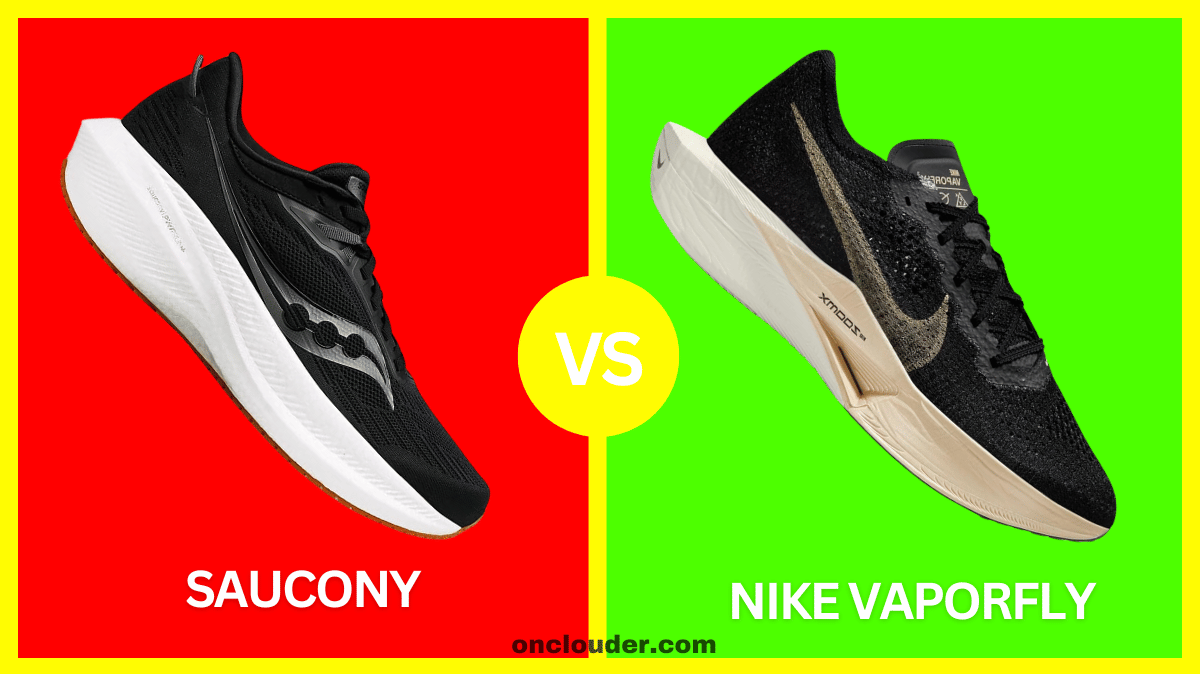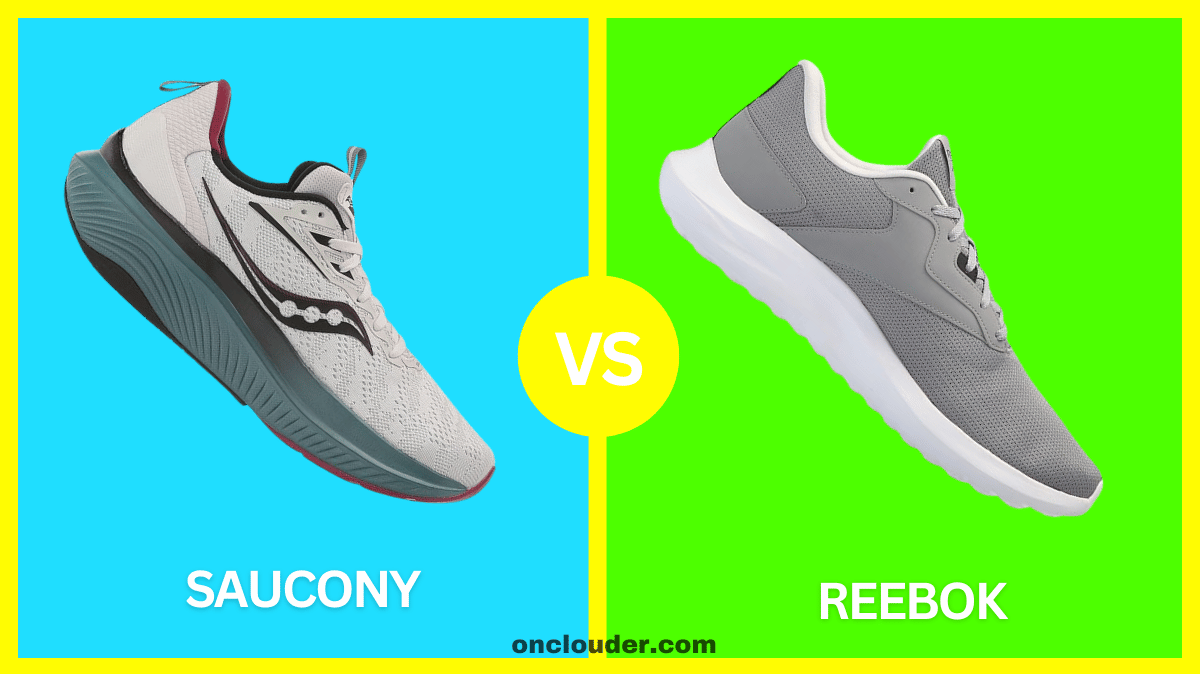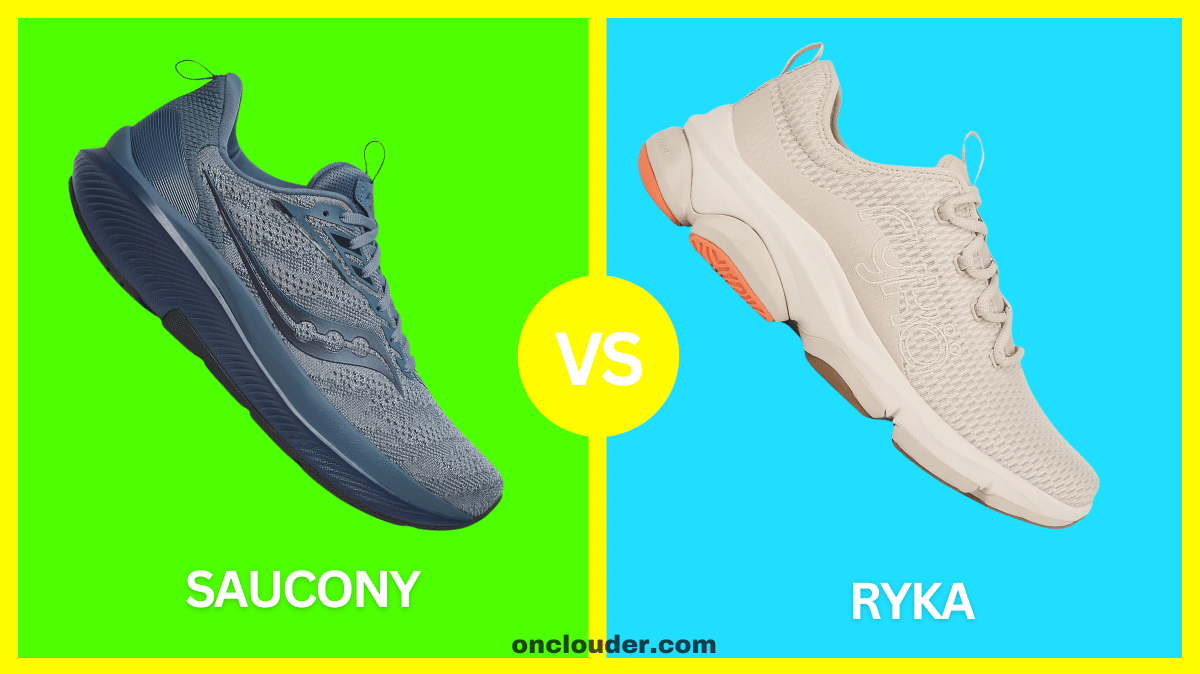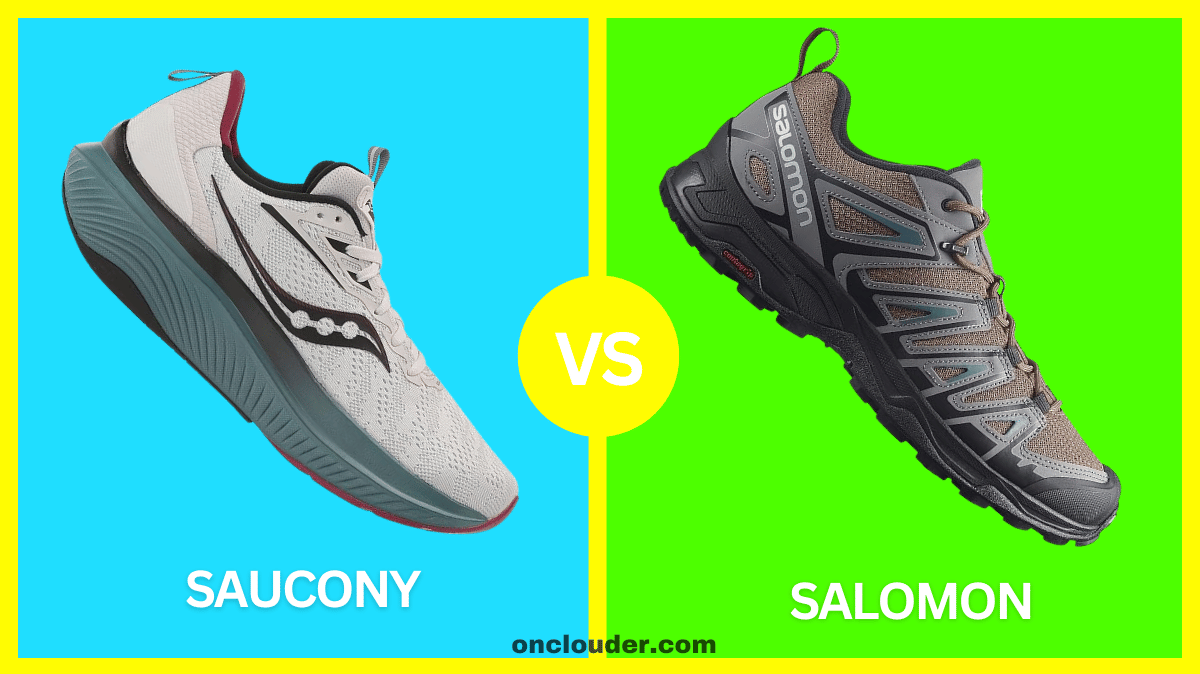Are you trying to choose between Saucony and Nike Vaporfly shoes? Don’t worry, we’ve got you covered.
We’ll compare these two popular brands and help you figure out which one might be the best fit for your feet.
Let’s dive in and explore the world of running shoes!

Contents
- 1 Quick Comparison: Saucony vs Nike Vaporfly Shoes
- 2 What Makes These Brands Special?
- 3 Durability: Which Shoe Lasts Longer?
- 4 Breathability: Keeping Your Feet Cool
- 5 Cushioning: Soft Steps or Firm Footing?
- 6 Shoe Fit: Finding Your Perfect Match
- 7 Stability: Keeping You on Track
- 8 Comfort: Happy Feet, Happy Runner
- 9 Quality: Built to Last?
- 10 Style: Looking Good on the Run
- 11 Size: Finding the Right Fit
- 12 Material: What Are These Shoes Made Of?
- 13 Weight: Light as a Feather?
- 14 Flexibility: Bend and Flex
- 15 Water Resistance: Staying Dry
- 16 Sole: Where the Rubber Meets the Road
- 17 User Reviews and Prices
- 18 Conclusion
- 19 Frequently Asked Questions
Quick Comparison: Saucony vs Nike Vaporfly Shoes
The main difference between Saucony and Nike Vaporfly shoes is their purpose. Saucony makes a wide range of shoes for everyday running and training, while Nike Vaporfly focuses on high-performance racing shoes.
Saucony offers more variety in styles and fits, while Nike Vaporfly uses cutting-edge technology to boost speed. Saucony shoes are often more durable and affordable, but Nike Vaporfly might give you that extra edge in races.
Now, here’s a detailed comparison table for “Saucony vs Nike Vaporfly Shoes“:
| Feature | Saucony | Nike Vaporfly |
| Purpose | Everyday running, training | Racing, speed |
| Durability | More durable, lasts longer | Less durable, wears out faster |
| Cushioning | Various types, balanced | Springy ZoomX foam |
| Fit | Wide range of fits | Snug, performance fit |
| Stability | Offers stability options | Less stable, focus on speed |
| Weight | Range from light to medium | Very lightweight |
| Price | More affordable | More expensive |
| Technology | Traditional running tech | Cutting-edge speed tech |
| Style | Classic sporty look | Modern, unique design |
| Best for | Daily training, long runs | Races, speed workouts |
In Summary: Saucony and Nike Vaporfly shoes are both great, but for different reasons. Saucony is awesome for everyday running and comes in lots of comfy styles that won’t cost too much.
Nike Vaporfly is super speedy and uses cool new technology, but it’s pricier and best saved for race day. Think about what you need most in a running shoe – comfort and durability, or speed and cool tech – to help you choose between these two brands.
What Makes These Brands Special?
Before we get into the details, let’s talk about why Saucony and Nike Vaporfly are such big names in the running world.
Saucony: A Long-Standing Favorite
Saucony has been making shoes since 1898! That’s over 120 years of experience. They’re known for making comfortable, reliable shoes that many runners love.
Nike Vaporfly: The New Speed King
Nike Vaporfly is a newer shoe line that’s become super popular with marathon runners. These shoes are designed to help you run faster and use less energy.
Now that we know a bit about each brand, let’s compare them in different areas.
Durability: Which Shoe Lasts Longer?
When you’re running, you want shoes that won’t fall apart quickly. Let’s see how Saucony and Nike Vaporfly stack up.
Saucony’s Staying Power
Saucony shoes are known for being tough. Many runners say their Saucony shoes last for hundreds of miles before showing signs of wear.
Nike Vaporfly’s Trade-off
Nike Vaporfly shoes are super light and fast, but they might not last as long as Saucony shoes. Some runners say they start to wear out after about 200-300 miles.
Breathability: Keeping Your Feet Cool
Nobody likes sweaty, stinky feet. Both Saucony and Nike try to make shoes that let your feet breathe.
Saucony’s Airy Approach
Most Saucony shoes have mesh uppers that let air flow in and out. This helps keep your feet cool and dry during long runs.
Nike Vaporfly’s Snug Fit
Nike Vaporfly shoes also use breathable materials, but they have a tighter fit. This means they might not feel as airy as some Saucony models.
Cushioning: Soft Steps or Firm Footing?
The cushioning in your shoes can make a big difference in how comfortable your run is. Let’s see how these brands handle cushioning.
Saucony’s Balanced Bounce
Saucony uses different types of cushioning in their shoes. Some models have lots of soft padding, while others are firmer for faster running.
Nike Vaporfly’s Springy Tech
Nike Vaporfly shoes use special foam and a carbon fiber plate to give you a bouncy feel. This can help you run faster and use less energy.
Shoe Fit: Finding Your Perfect Match
Getting the right fit is super important for comfort and preventing injuries. Here’s how Saucony and Nike Vaporfly compare.
Saucony’s Variety
Saucony makes shoes in lots of different shapes and sizes. This means you’re more likely to find a shoe that fits your foot just right.
Nike Vaporfly’s Snug Embrace
Nike Vaporfly shoes have a tighter fit. They’re designed to hug your foot closely, which some runners love and others find too snug.
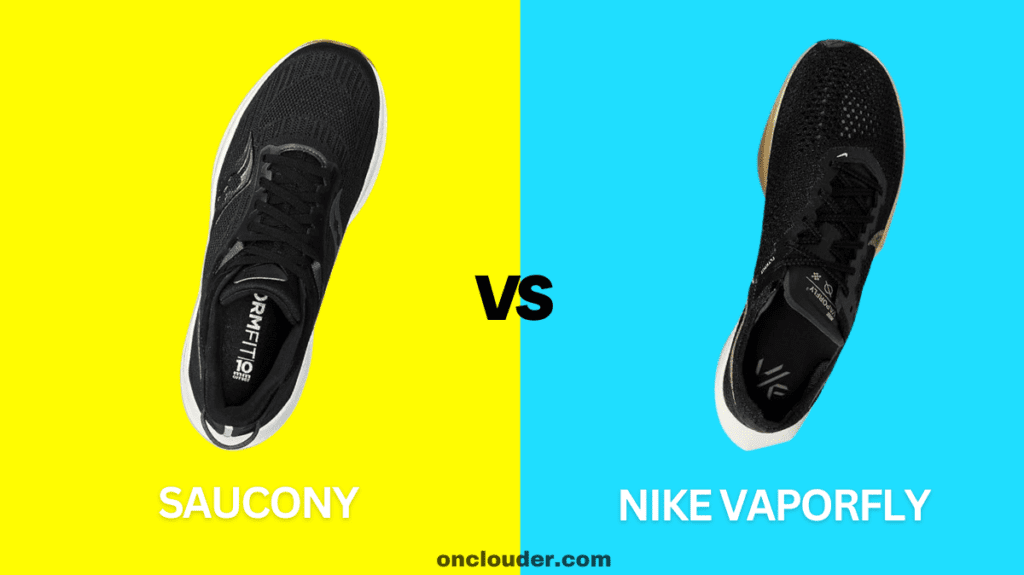
Stability: Keeping You on Track
If your feet tend to roll inward (called overpronation) when you run, you might need shoes with extra stability. Let’s see what our two brands offer.
Saucony’s Supportive Options
Saucony makes several shoes designed for stability. These can help keep your feet aligned and prevent injuries.
Nike Vaporfly’s Speed Focus
Nike Vaporfly shoes are mainly designed for speed, not stability. If you need a lot of support, these might not be the best choice for you.
Comfort: Happy Feet, Happy Runner
Comfort is key when you’re running long distances. Both brands try to make shoes that feel good on your feet.
Saucony’s All-Day Comfort
Many runners say Saucony shoes feel comfortable right out of the box and stay comfy for long runs.
Nike Vaporfly’s Performance Comfort
Nike Vaporfly shoes are comfortable in a different way. They’re designed to feel good when you’re running fast, but might not be as cozy for everyday wear.
Quality: Built to Last?
When you spend money on running shoes, you want them to be well-made. Let’s look at the quality of these two brands.
Saucony’s Solid Reputation
Saucony has a long history of making quality shoes. They use good materials and pay attention to details.
Nike Vaporfly’s Cutting-Edge Tech
Nike Vaporfly shoes use new technologies and materials. While they’re well-made, some runners worry about how long these high-tech shoes will last.
Style: Looking Good on the Run
Let’s face it: we all want shoes that look cool. Both Saucony and Nike offer stylish options.
Saucony’s Classic Cool
Saucony shoes often have a classic, sporty look. They come in lots of colors and designs.
Nike Vaporfly’s Futuristic Flair
Nike Vaporfly shoes have a unique, modern look. They stand out with their thick soles and sleek designs.
Size: Finding the Right Fit
Getting the right size is crucial for comfort and performance. Here’s what you need to know about sizing for these brands.
Saucony’s True-to-Size Trend
Most runners find that Saucony shoes fit true to size. This means you can usually order your normal shoe size.
Nike Vaporfly’s Snug Sizing
Nike Vaporfly shoes often run a bit small. Some runners recommend going up half a size for the best fit.
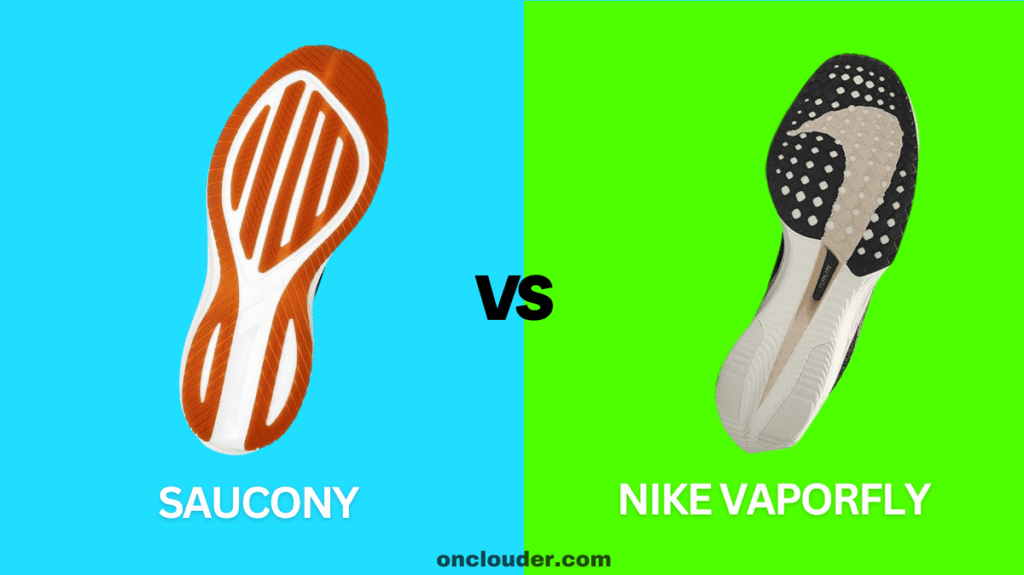
Material: What Are These Shoes Made Of?
The materials used in running shoes affect how they feel, how long they last, and how they perform. Let’s compare the materials used by Saucony and Nike Vaporfly.
Saucony’s Trusted Textiles
Saucony uses a mix of materials including:
- Mesh uppers for breathability
- EVA foam for cushioning
- Rubber outsoles for durability
Nike Vaporfly’s High-Tech Fabrics
Nike Vaporfly shoes use some unique materials:
- ZoomX foam for lightweight cushioning
- Carbon fiber plate for energy return
- Vaporweave upper for a lightweight, water-resistant fit
Weight: Light as a Feather?
The weight of your shoes can affect how fast you run and how tired your legs get. Let’s see how these brands compare in terms of weight.
Saucony’s Balanced Approach
Saucony makes shoes in a range of weights. Some are light for racing, while others are a bit heavier but offer more support.
Nike Vaporfly’s Featherweight Focus
Nike Vaporfly shoes are designed to be super lightweight. This can help you run faster, but some runners find them too light for everyday training.
Flexibility: Bend and Flex
How much your shoe bends can affect how natural your stride feels. Let’s look at the flexibility of these two brands.
Saucony’s Natural Movement
Many Saucony shoes are designed to flex with your foot, allowing for a more natural running motion.
Nike Vaporfly’s Stiff Speed
Nike Vaporfly shoes are stiffer due to the carbon fiber plate. This helps with speed but might feel less natural for some runners.
Water Resistance: Staying Dry
Sometimes you have to run in the rain. How do these shoes handle wet conditions?
Saucony’s Weather Protection
Some Saucony models have water-resistant uppers to help keep your feet dry in light rain.
Nike Vaporfly’s Speedy Spirits
Nike Vaporfly shoes aren’t designed for wet conditions. They’re more focused on speed than weather protection.
Sole: Where the Rubber Meets the Road
The sole of your shoe is super important. It provides traction, cushioning, and affects how your foot moves. Let’s compare the soles of Saucony and Nike Vaporfly shoes.
Saucony’s Grip and Go
Saucony uses different types of rubber soles depending on the shoe model. Many have good traction for various surfaces.
Nike Vaporfly’s Speedy Setup
Nike Vaporfly soles are designed for speed on roads. They have a unique shape that helps roll your foot forward as you run.
Now, let’s look at some user reviews and prices to help you make your decision.
User Reviews and Prices
Here’s a quick comparison of user ratings and prices for popular models from each brand:
| Brand & Model | User Rating | Price Range |
| Saucony Ride 13 | ⭐⭐⭐⭐½ (4.5/5) | $130 – $150 |
| Saucony Kinvara 12 | ⭐⭐⭐⭐ (4/5) | $110 – $130 |
| Nike Vaporfly NEXT% | ⭐⭐⭐⭐½ (4.5/5) | $250 – $275 |
| Nike Vaporfly 4% Flyknit | ⭐⭐⭐⭐ (4/5) | $220 – $250 |
Remember, prices can change, so always check the latest prices before making a decision!
Pros and Cons
| Brand | Pros ✅ | Cons ⚠️ |
|---|---|---|
| Saucony | Comfy for long runs | Not as speedy |
| Lots of styles to choose from | Might look less cool | |
| Good for everyday use | Not the latest tech | |
| Won’t break the bank | Heavier than Vaporfly | |
| Nike Vaporfly | Super fast for races | Costs a lot of money |
| Cool, modern look | Not great for daily runs | |
| Uses awesome new tech | Might wear out quickly | |
| Very light on your feet | Not good for stability |
Conclusion
After comparing Saucony and Nike Vaporfly shoes, we can see that both brands have their strengths. Here’s a quick summary to help you choose:
Choose Saucony if you want:
- Durable shoes for everyday training
- A wide range of styles and fits
- Good value for money
Choose Nike Vaporfly if you want:
- Super lightweight shoes for racing
- Cutting-edge technology for speed
- A unique, modern look
Remember, the best shoe for you depends on your individual needs, running style, and preferences. It’s always a good idea to try on shoes before buying if possible!
Frequently Asked Questions
Are Saucony shoes good for beginners?
Yes! Saucony offers many models that are great for new runners. They provide good support and comfort at reasonable prices.
Are Nike Vaporfly shoes worth the high price?
If you’re a serious runner looking to improve your race times, many people find Nike Vaporfly shoes worth the investment. For casual runners, there might be more budget-friendly options.
Can I use Nike Vaporfly shoes for everyday training?
While you can, most runners save their Vaporfly shoes for races or speed workouts. They’re expensive and may wear out faster with daily use.
Do Saucony shoes come in wide sizes?
Yes, many Saucony models come in wide sizes. This makes them a good choice if you have wider feet.
How often should I replace my running shoes?
Most experts recommend replacing your running shoes every 400-500 miles. This can vary based on your weight, running style, and the surfaces you run on.

